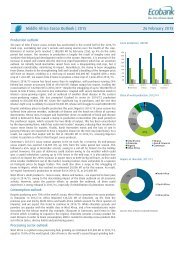www.ebook777.com
Make_Getting_Started_with_Processing_Second_Edition
Make_Getting_Started_with_Processing_Second_Edition
You also want an ePaper? Increase the reach of your titles
YUMPU automatically turns print PDFs into web optimized ePapers that Google loves.
Define a Class<br />
Before you can create an object, you must define a class. A<br />
class is the specification for an object. Using an architectural<br />
analogy, a class is like a blueprint for a house, and the object is<br />
like the house itself. Each house made from the blueprint can<br />
have variations, and the blueprint is only the specification, not a<br />
built structure. For example, one house can be blue and the<br />
other red; one house might come with a fireplace and the other<br />
without. Likewise with objects, the class defines the data types<br />
and behaviors, but each object (house) made from a single<br />
class (blueprint) has variables (color, fireplace) that are set to<br />
different values. To use a more technical term, each object is an<br />
instance of a class and each instance has its own set of fields<br />
and methods.<br />
Before you write a class, we recommend a little planning. Think<br />
about what fields and methods your class should have. Do a little<br />
brainstorming to imagine all the possible options and then<br />
prioritize and make your best guess about what will work. You’ll<br />
make changes during the programming process, but it’s important<br />
to have a good start.<br />
For your fields, select clear names and decide the data type for<br />
each. The fields inside a class can be any type of data. A class<br />
can simultaneously hold many images, boolean, float,<br />
and String values, and so on. Keep in mind that one reason to<br />
make a class is to group together related data elements. For<br />
your methods, select clear names and decide the return values<br />
(if any). The methods are used to change the values of the fields<br />
and to perform actions based on the fields’ values.<br />
For our first class, we’ll convert Example 8-9 on page 110 from<br />
earlier in the book. We start by making a list of the fields from<br />
the example:<br />
float x<br />
float y<br />
int diameter<br />
float speed<br />
The next step is to figure out what methods might be useful for<br />
the class. In looking at the draw() function from the example<br />
Objects 137



